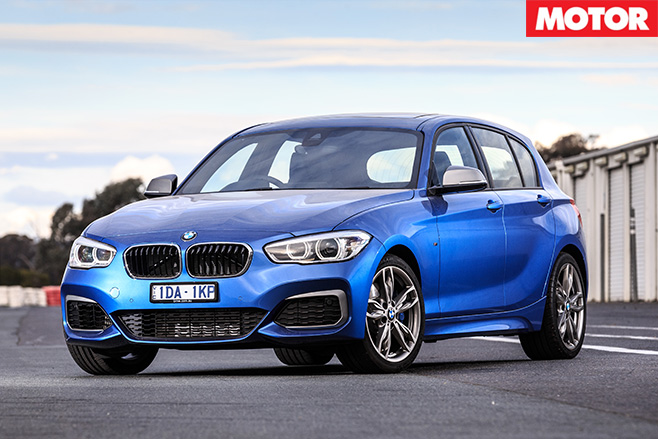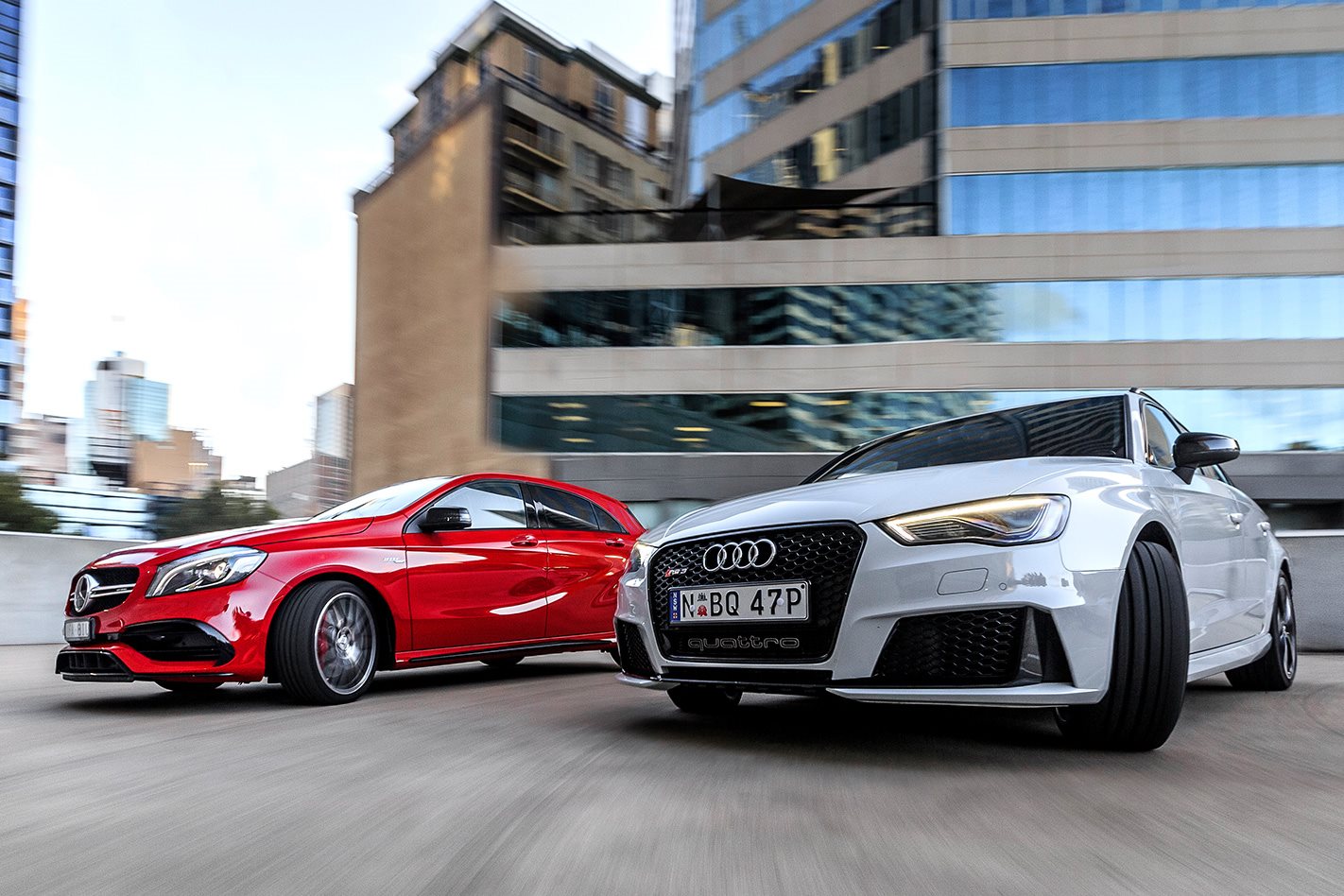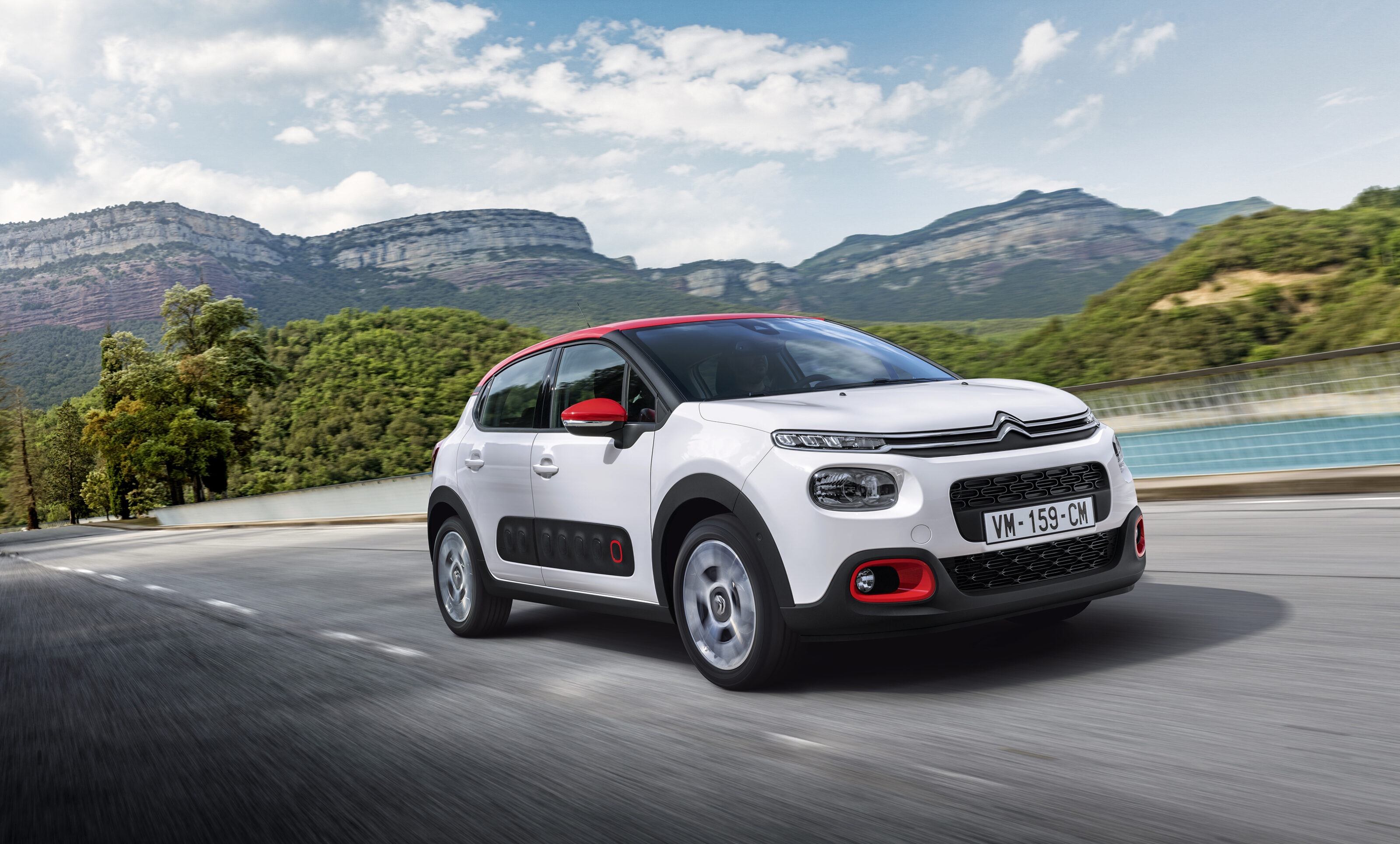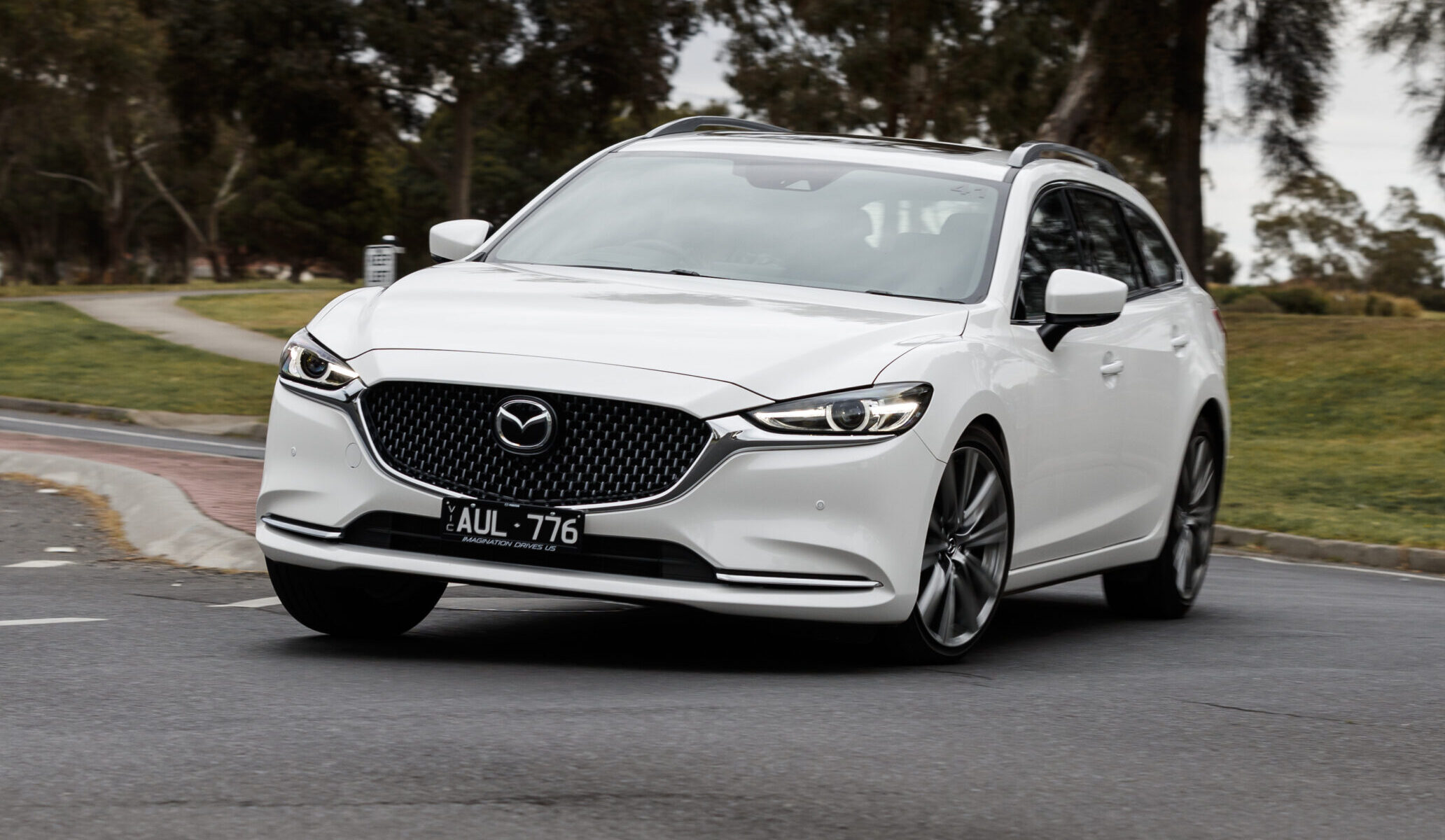Welcome to the battle of the uber-hatches. No, this doesn’t mean that either the Audi RS3 or Mercedes-AMG A45 will transport you home after a big night out with a tap of your smartphone.
Instead, by offering supercar performance in a five-door body, they satisfy the true definition of uber: being a superlative example of its kind or class.
As premium manufacturers push downwards into new, volume-selling segments, yet customers demand ever greater performance from the go-fast variants, the hot hatch arms race is accelerating as fast as the cars themselves. But this speed comes at a cost.
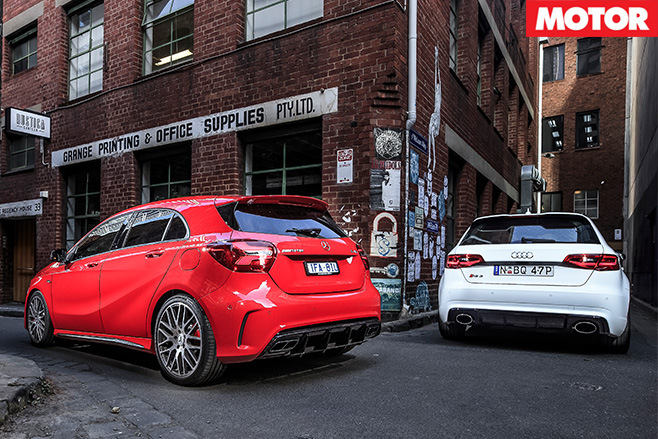
And you can spend plenty more than that, including $4500 for RS bucket seats and $8990 for carbon-ceramic brakes. Neither of these – nor the external bling – is strictly necessary, but the RS Performance Package is a must-tick option, for reasons that will become clear later.
Mercedes takes a more inclusive approach to pricing, the only option on our $77,900 A45 the $1990 Dynamic Plus package, which adds tyre pressure monitoring and the new mechanical front limited-slip differential. Aussie A45s come loaded with gear that’s optional overseas – metallic paint, climate control, sunroof, keyless entry-and-go, Recaro seats, leather, even the shift paddles – which gives it a handy $10K advantage before we even turn the keys.
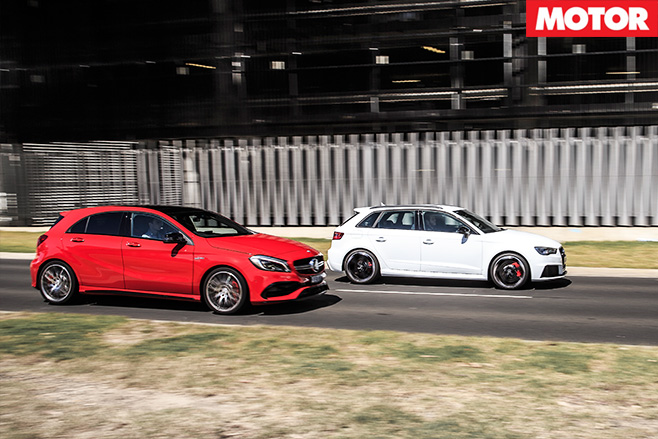
Which brings us to the business of those superlatives – these might be very expensive small cars, but they are also performance bargains. AMG claims the updated A45 can hit 100km/h in a ludicrous 4.2sec – that can’t be right, can it? That’s faster than an Audi R8 V8, a twin-turbo W12 Bentley Continental GT, or any Maserati.
Activating the AMG’s launch control is a bit of a process: select RACE on the new Dynamic Select controller, select Manual for the transmission and press firmly with your left foot on the brake. Now pull both paddles back towards you until “Race Start” appears on the central instrument display; pull the right paddle to confirm, floor the accelerator and revs rise to just shy of 4000rpm, the engine stuttering against a temporary limiter.
Lift off the brake and the A45 fires off the line, short-shifting into second and third despite the unbreachable traction offered by all-wheel drive. Do anything but sit there with your right foot welded to the carpet – lift slightly, change gear manually – and the program will cancel so there’s nothing to do but watch as 100km/h flashes up in 4.16sec and the quarter mile in 12.41sec at 180.23km/h.
Conventional thinking would have you believe a 2.0-litre turbo four-cylinder producing this much grunt would be a laggy, top-end monster, but nothing could be further from the truth. It takes a moment to gather its breath – all 26psi of it – but the mid-range is massive and it feels utterly unstressed at high rpm.
So unstressed that it’s easy to run into the 6700rpm limiter during hard driving, particularly as the new, slightly shorter gearing is a little awkward. On some roads you sometimes find yourself caught between two gears – usually third and fourth – and the seven-speed dual-clutch isn’t fond of delivering shifts in a timely manner.
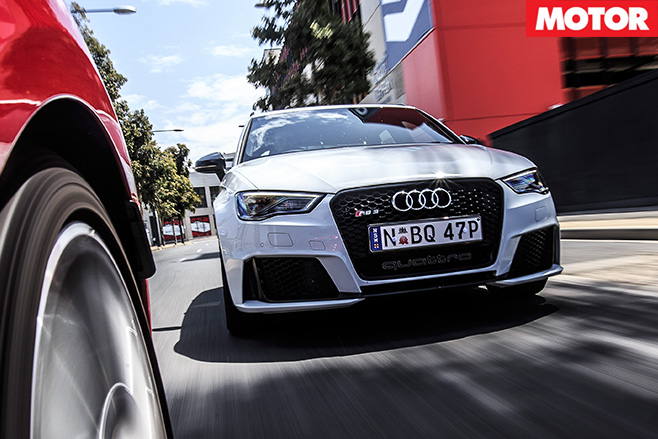
The RS3’s seven-speed dual-clutch is much slicker, with faster changes, more responsive shifts and longer ratios, which means you’re flicking paddles with less frequency. The only blot on its copybook is that manually changing from first-to-second under full throttle occasionally sends a fearsome shock through the whole car with a bang that sounds for all the world like the gearbox has just fallen through the floor.
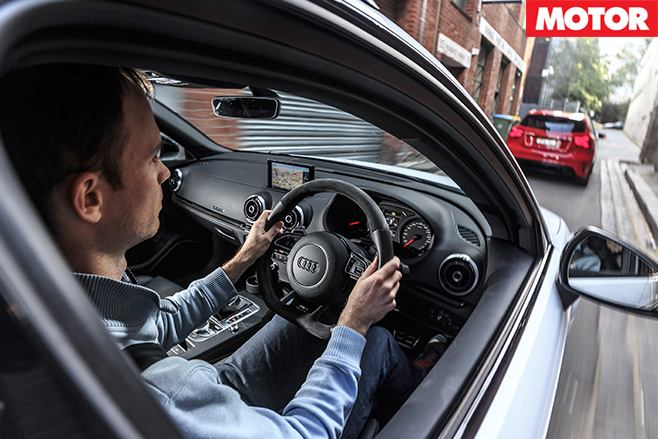
For rally fans, that note will act like an automotive Tardis, instantly transferring them 30 years back in time. Audi may have plonked an S1 badge on its hi-po supermini, but it’s the RS3 that best pays tribute to its famous WRC predecessors. One second you’re having a fang on your favourite twisty road, the next you’re Stig or Hannu attacking a Corsican special stage, swept away on a wave of nostalgia.
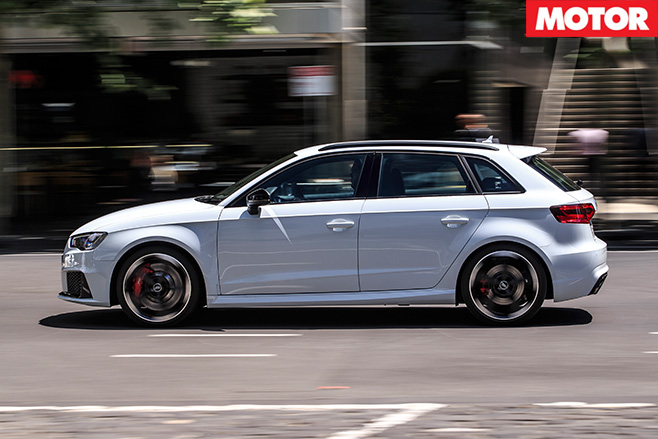
Its off-the-line punch is brutal, yet on the road the speed feels even more other-worldly. It charges down straights with relentless efficiency, not a single kilowatt wasted thanks to quattro traction. It’s an experience that can leave you breathless, so why is there a bright red Mercedes resolutely stuck to the RS3’s rear bumper, lights ablaze?
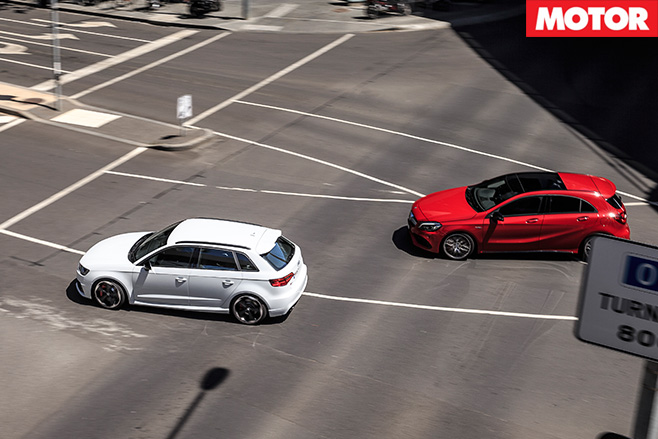
Mid-corner bumps that are summarily dispatched by the AMG’s excellent new adaptive dampers send the RS3’s optional magnetic dampers crashing into their bump stops. The trick suspension comes as part of the aforementioned RS Performance Package, which also brings with it wider 255mm front tyres (rears are 235mm). The extra front rubber helps, but ultimately fails to stop that big 2.5-litre five-pot slung ahead of the front axle from dragging the nose wide.
Oddly, it feels better on track, stable and planted but with just enough adjustability to keep you entertained or allow you to adjust your line if you get it slightly wrong. Unusually for a road car, it rides Sandown’s high kerbs well and punches out of its tight corners with furious anger. Acceleration slows markedly over about 170km/h – blame that longer gearing – but its biggest downside on track is its brakes.
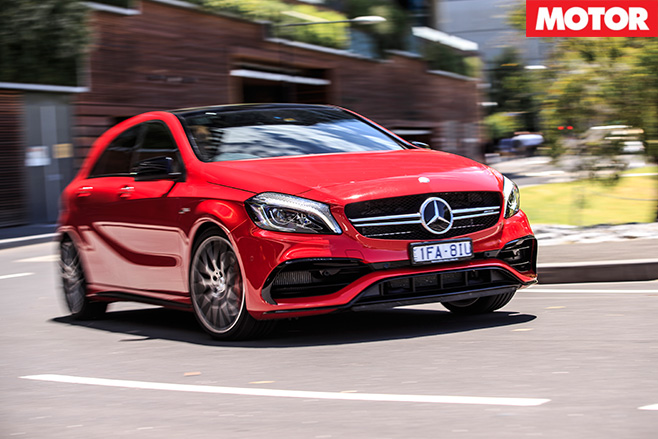
The A45’s stoppers also feel the heat on consecutive hot laps, however, after a short cool-down, recover quickly and are ready to go again. It stops so well the rear end finally starts to wander around under brakes, but from the moment you turn in, it relies heavily on its front end for purchase.
The optional mechanical front diff means there is a very definite technique to extracting the best out of the AMG, and it’s tricky to nail. Carrying too much entry speed pushes the front wide and accelerating only increases the problem; the key seems to be to slow the car more than feels natural and exit squarer, but it’s a delicate balancing act.
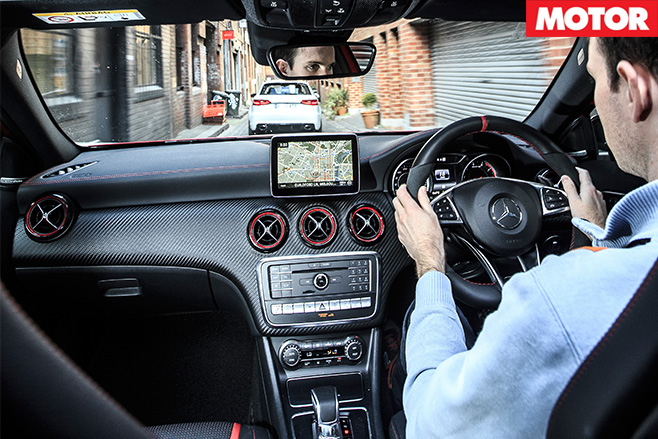
But it’s not. Despite the RS3 gaining time across the kerbs and feeling more fluid from behind the wheel, the A45 is eight-tenths faster, clocking 1:25.4 to the Audi’s 1:26.2. It neatly aligns with our findings on the road; the Audi feels faster, but it’s the Mercedes that’s delivering the goods. The only conclusion to make is the A45 reaches its limits with so much stability and so little drama that you’re actually going much faster than you realise. It’s a four-wheeled Terminator – a ruthless road-killing machine.
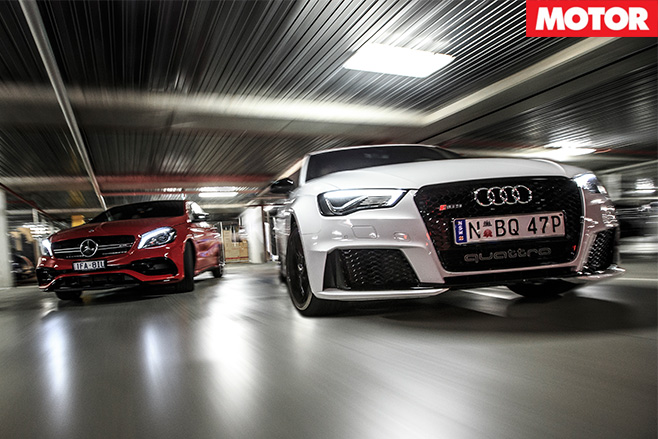
The Audi isn’t bad, but fidgets more than the A45 and there’s quite a lot of suspension noise, too, though its cabin is noticeably quieter in terms of tyre and wind noise. The Merc’s seats are superior in terms of lateral support, but can be wearing on longer trips, and it’s ergonomically not a match for the RS3.
Throughout this comparison, the two combatants have traded blows like Foreman and Ali in the Thrilla in Manila, which makes picking a winner a tough task. The updated A45 is faster on road and track, and if you take away the RS3’s initial launch advantage, just as quick in a straight line. It’s also significantly cheaper, however it seems unlikely that fiscal considerations will play a large part in the purchasing decisions of those willing to drop $80K on a hot hatch.
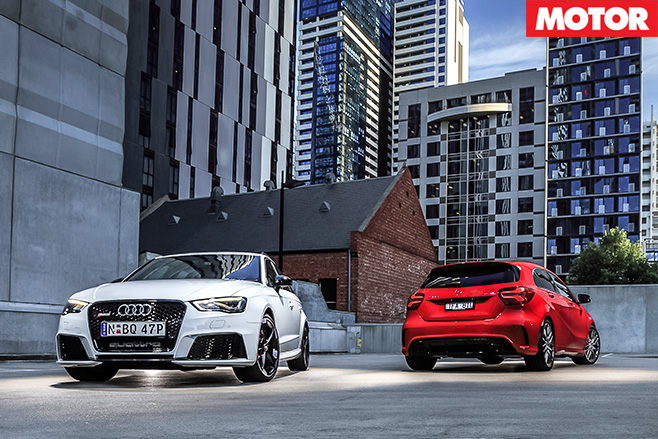
Both these cars are so quick and capable that it would take some very exotic machinery to stay with them in most circumstances, however the Audi has more of a sense of humour about it. If you’re a hard driver who likes to hit the track, the A45 is for you. For day-to-day use, take the RS3.
| u00a0 | AUDI RS3 | MERCEDES-AMG A45 |
| Body | 5-door, 5-seat hatch | 5-door, 5-seat hatch |
| Drive | all-wheel | all-wheel |
| Engine | 2480cc inline-5, DOHC, 20v, turbo | 1991cc inline-4, DOHC, 16v, turbo |
| Bore/stroke | 82.5 x 92.8mm | 82.0 x 92.0mm |
| Compression | 10.0:1 | 8.6:1 |
| Power | 270kW @ 5550-6800rpm | 280kW @ 6000rpm |
| Torque | 465Nm @ 1625-5550rpm | 475Nm @ 2250-5000rpm |
| Power/weight | 178kW/tonne | 189kW/tonne |
| Transmission | 7-speed dual-clutch | 7-speed dual-clutch |
| Weight | 1520kg | 1480kg |
| Suspension(F) | struts, coil springs, magnetic dampers, anti-roll bar | struts, adaptive dampers, coil springs, anti-roll bar |
| Suspension(R) | multi-links, coil springs, magnetic dampers, anti-roll bar | multi-links, coil springs, adaptive dampers, anti-roll bar |
| L/W/H | 4343/1800/1411mm | 4367/1780/1417mm |
| Wheelbase | 2631mm | 2699mm |
| Tracks | 1559/1514mm (f/r) | 1557/1561mm (f/r) |
| Steering | electrically-assisted rack-and-pinion | electrically-assisted rack-and-pinion |
| Brakes(F) | 365mm ventilated discs, 8-piston calipers | 350mm drilled ventilated discs, 4-piston calipers |
| Brakes(R) | 310mm ventilated discs, single-piston calipers | 330mm drilled ventilated discs, single-piston calipers |
| Wheels | 19.0 x 8.0-inch (f/r) | 19.0 x 8.0-inch (f/r) |
| Tyre Sizes | 245/35 ZR20 (f); 305/30 ZR20 (r)u00a0 | 255/35 R19 (f); 285/30 R19 (r)u00a0 |
| Tyre | Pirelli P Zero R01 | Continental ContiSportContact 5P |
| Price as tested | $89,265u00a0 | $79,890 |
| Pros | Awesome engine; great interior; the noise | So, so fast; improvements over predecessor; value |
| Cons | Expensive; nose heavy; average brakes | Needs to be more involving; slow gearbox |
| Star Rating | 4/5 | 4/5 |
Worth considering
…the other (other) German hatch
BMW’s M135i wasn’t included in this test, as at $62,900 it’s $15K less than a basic A45 or RS3. However, with one recently installed in the MOTOR garage, comparisons had to be drawn.
It’s mildly outgunned in standard form, however spend the money saved on a light tune and the optional LSD and you have a car that would be every bit as fast in a straight line and more involving thanks to its rear-drive chassis. Some will enjoy the security offered by the all-wheel drive Audi and AMG, but Bimmer’s little blue bullet is worth a look.
